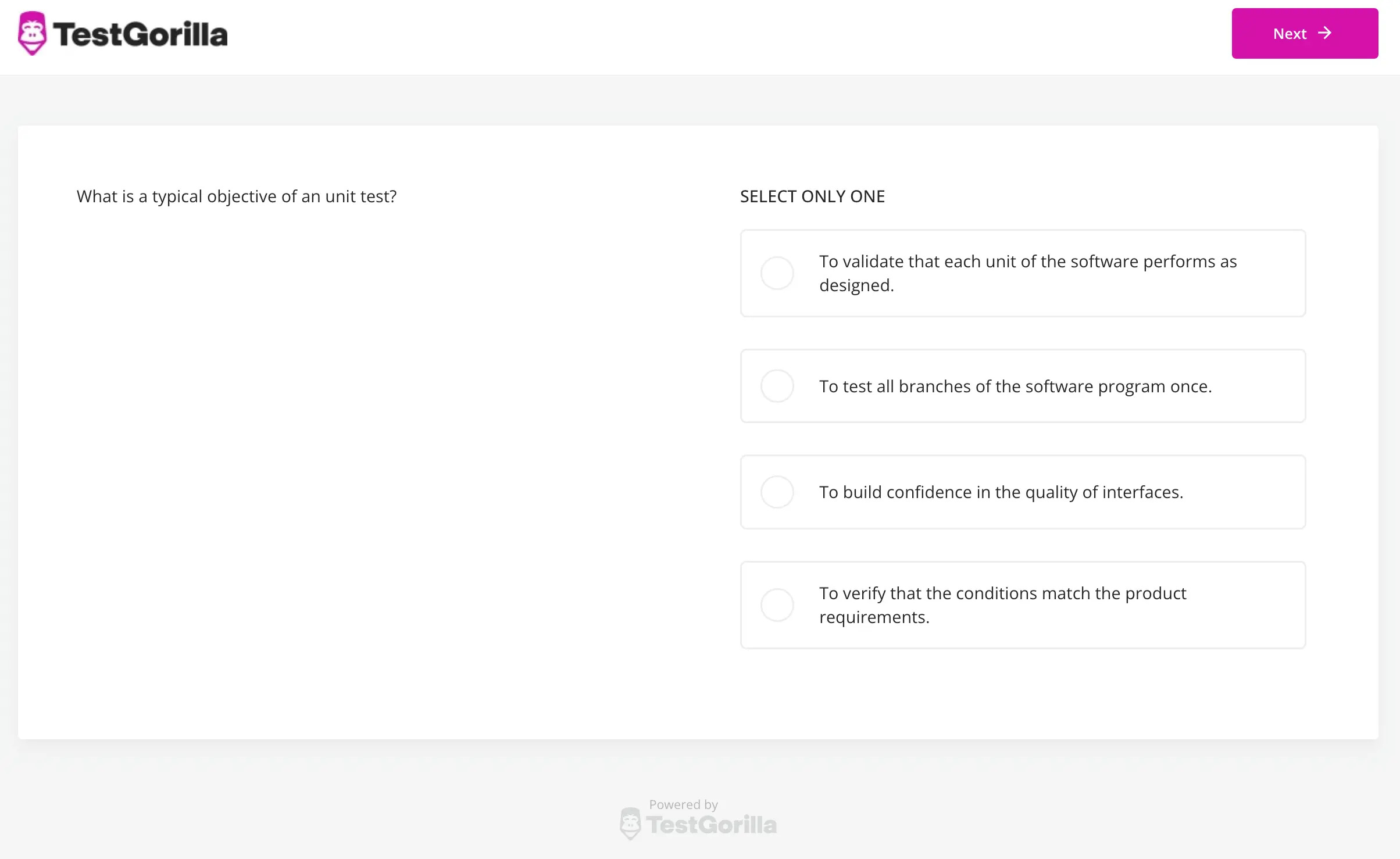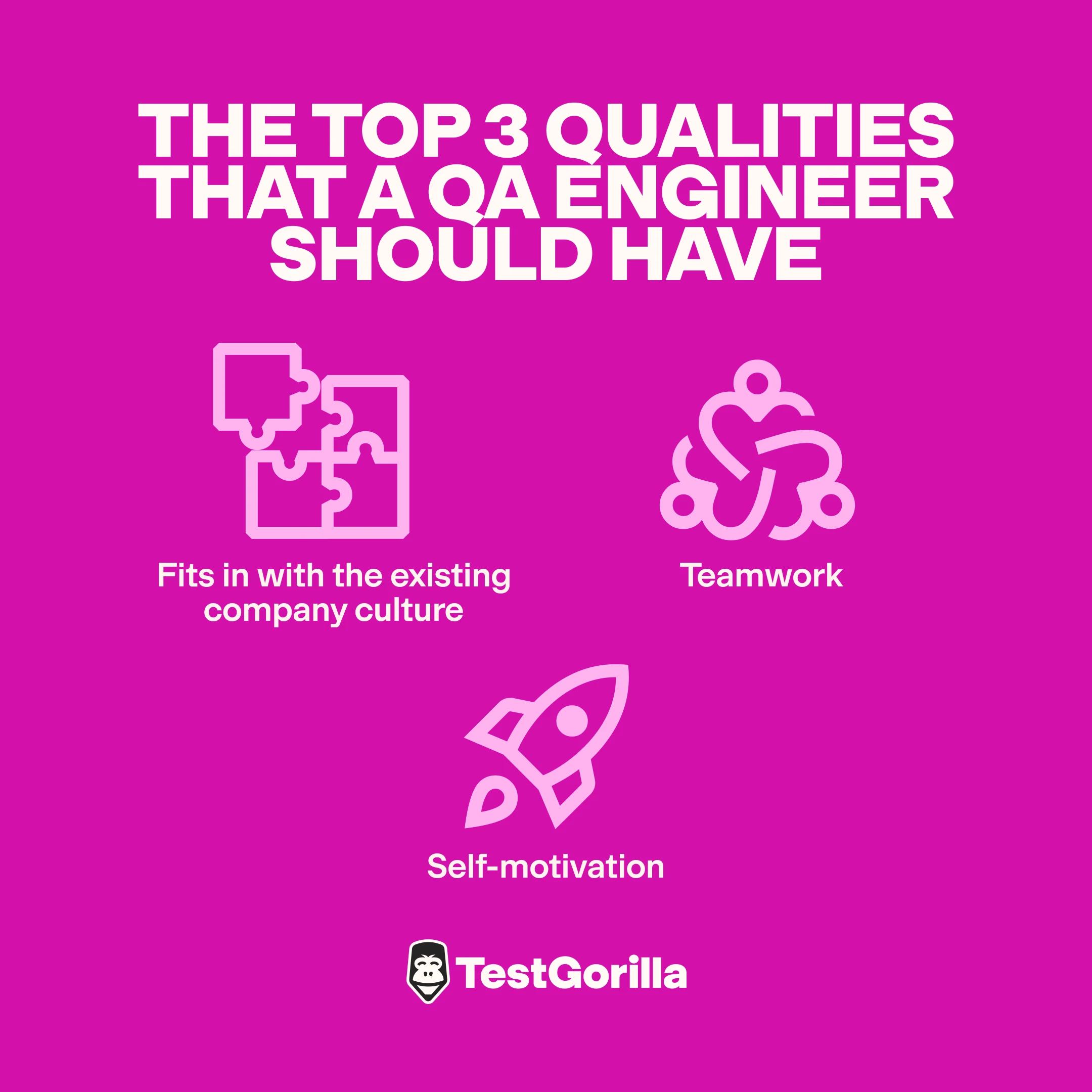50 quality assurance interview questions to hire the best QA engineers
Assess quality assurance engineers' skills with TestGorilla
Hiring the best quality assurance (QA) engineers is crucial, because they’ll look after your company’s software-development standards and enforce them.
In a way, they’re the guardians of your company’s reputation, so you must make sure to choose the best candidates.
That’s why it’s so important to ask the right QA interview questions and combine this with other skills assessments, such as skills tests. Using both approaches will enable you to comprehensively evaluate candidates’ expertise and knowledge and make sure they’re the right fit.
You can use our QA/Test Engineer test to assess candidates and invite only the best to interview. This way, you’ll save time and money and only concentrate on those applicants who have the right skills. Candidates who perform well on this test understand the fundamentals of quality assurance.
In this article, we’ve put together a complete guide to help you assess QA engineers, including the following:
What is quality assurance?
The qualities to look out for in a QA engineer
A list of 50 quality assurance interview questions to use when interviewing your next QA engineer (which you can also include them as custom questions in online tests)
We’ve also provided sample responses to each question with explanations to help you evaluate your candidates’ skills and knowledge.
Table of contents
What are quality assurance engineers?
If software developers were doctors, QA engineers would be the state medical boards who inspect them and ensure they’re not doing anything dangerous.
That’s the key difference between a QA engineer and a software developer: The latter builds applications while the former inspects the code and maintains standards.
Quality assurance engineers ensure that end users have a positive experience while mitigating risks such as refund requests (due to customer dissatisfaction), issues with the source code, litigations due to software malfunctions, etc.
Therefore, they will support developers throughout the software development lifecycle, from app creation to testing and implementation.
This means QA engineers must be highly knowledgeable in different areas and be able to:
Identify software bugs successfully
Use the appropriate test strategies
Use the right automation and test-management tools
Know how to find and read the appropriate documentation, and more
What are the top 3 qualities that a QA engineer should have?
A quality assurance engineer needs to have the relevant skills and experience to be successful in their role.
QA engineers need to have experience in quality assurance, as well as the right practical knowledge of QA tools, workflows, and language (vocabulary or jargon). They might have a bachelor’s degree in computer science or a related field, although this isn’t a must.
You can evaluate candidates’ skills before the interview stage with a robust online QA/Test engineer test (preview below).
However, it’s not just these hard skills that are important. Soft skills and cognitive abilities can outweigh experience and hard skills, which conscientious candidates can learn on the job.
Here are the top three qualities of a successful QA engineer:
1. Teamwork
QA engineers are expected to work within teams. They may also be in touch with and report to other departments, such as finance and senior management.
Strong communication skills and the ability to work with other people at all levels are a must.
2. Self-motivation
Quality assurance engineers are at the forefront of building and maintaining the company’s reputation.
For this reason, highly motivated individuals who are self-starters and always look for ways to improve their work and help others will be a valuable addition to the team.
You can assess your candidates for this using a Motivation test.
3. Fits in with the existing company culture
As explained earlier, QA engineers work very closely with software developers and occasionally with other teams and departments. It’s important they not only understand the company culture but are aligned with it and able to seamlessly fit in with your team.
A good way to evaluate this is to use a Culture Add test, where you can compare your candidates’ values and behaviors with those of your organization.
What interview questions should you ask your future quality assurance engineer?
You must ask two types of QA testing interview questions: personality and culture questions and technical questions.
Technical questions enable you to find out whether your candidate has the skills and expertise, while personality and culture questions help you assess whether they will fit in with the current team and business.
Personality and culture interview questions for a QA engineer
In this section, you’ll find 10 QA interview questions related to personality and culture, plus sample answers for each one.
1. What makes you a good fit for the job?
Remember, hard skills are not the be-all and end-all of successful recruitment.
With this question, you give your candidates a chance to talk about their personality as well as their skills. Look out for candidates who show passion instead of just talking about their experience and skills.
2. Are QAs responsible for resolving production problems?
Some QA candidates may say “no” to this question. You’re looking for a yes.
When production issues arise, QA engineers are often a valuable asset and help solve them efficiently. To identify problems, they should create test cases when possible. As a result, quality assurance minimizes the number of issues a product will have in the end.
A candidate who says “yes” to this question is more likely to be a team player and be motivated to do whatever it takes to overcome obstacles.
3. In your last project, what did you accomplish?
Here you’re trying to gauge a candidate’s experience and knowledge of QA tools, software, and methodologies.
But you’re also checking for evidence of teamwork, collaboration, problem-solving skills, and more.
Look for passion and pride. Capable quality assurance engineers are proud of their past projects and love to talk about them.
4. When you have a lot on your plate, how do you prioritize tasks?
Here, your candidate will most likely explain how they have handled busy times in the past.
Did they follow a strict schedule? Or are they more comfortable with a less fixed schedule, enabling them to adapt as needed and solve unexpected issues as they arise? Did they know when to ask for help? Were they able to prioritize tasks effectively?
This is a great question to ascertain whether your applicant has the right personality to fit into an existing team.
5. What is the most difficult project you have worked on?
This is an illuminating interview question for quality engineers, because it can reveal their true passion for their job. Look for candidates who were really involved in past projects and show a “refuse to fail” attitude.
Here, you’re giving candidates the chance to shine!
6. Describe a time when you missed a bug. What happened?
This question is important as it reveals desirable (or undesirable) personality traits.
No one can say they never make mistakes. So it’s a red flag if a candidate tries to insinuate their work is 100% error-free. They could be someone who passes the buck on issues and is not a team player.
Look for candidates who are honest about their errors and failures but then show how they worked alone and with others to resolve the problem and what they learned from the experience.
7. What is the best way to test a broken kettle?
This is a fun question, yet it can reveal a lot about your candidate’s creativity.
Questions like this can show whether a candidate can think on their feet and outside the box, which are great traits for a QA engineer to have.
8. What are the qualities that make a good QA leader?
This question is ideal if you’re hiring a QA member to lead a team or if the role has the potential to progress to a leadership position in the future.
It’s also a good idea to ascertain whether a candidate would fit well with the person likely to lead them if they get the position.
Here, you’re looking for candidates who talk about empowerment, honesty, autonomy, great communication and active listening.
9. Can you tell me what test metric you believe is most important?
You may consider this a trick question, because there isn’t a single metric that is more important than all others.
A quality assurance engineer will use different metrics depending on the type of test they conduct and the team’s goals.
The point of this question is to see if they know how to choose the right metrics depending on the specific tests and goals and what factors they take into consideration. It’s a good way to see how they think.
10. How would you describe your career goals?
As you’re likely aware, recruiting new employees is a costly business. By asking this question, you can see where your candidate sees themselves in the near and intermediate future, whether your role and company can meet their expectations, and whether they can meet yours.
Technical quality assurance interview questions
In this section, you’ll find 40 technical questions for QA engineering roles along with sample answers to all of them. These questions will enable you to evaluate your candidates’ knowledge and experience with software QA.
1. What is a software bug?
A bug in software is a failure or error within the software code. A bug will prevent the software from working correctly.
2. What’s the difference between severity and priority?
This is an important question for you to assess candidates’ time management skills.
Severity is the level of difficulty in fixing an issue, while priority is the level of importance of addressing it.
Severity is not always equal to priority. An issue could be difficult to fix, but not be of high priority. Conversely, an issue could be easy to fix but is a high priority.
An example of an issue that’s high severity and low priority could be a software malfunction for an in-house application that is not used often and has workarounds.
An example of an issue with low severity and high priority could be if the checkout cart of an online store is missing a crucial link to the store’s terms and conditions.
3. In test automation, how are the Assert and Verify commands different?
The Asset and Verify commands have a lot in common. Both check if the code conditions are met. What follows after the command’s execution makes a difference:
A failed assert command will pause the test and stop the execution of the code
A failed verify command will still execute the rest of the code
4. How are quality assurance, quality control, and testing different?
A quality assurance plan outlines how a team or organization will monitor the test process. A quality control process uncovers defects and suggests ways to improve the software. The testing process is how quality assurance and quality control find and fix bugs.
5. What is the best time to start QA?
It is important to begin QA as soon as possible. The earlier QA analysts, testers, and leads are involved in the process, the fewer software development headaches there will be. It is possible to test the software before it is fully functional by performing static tests.
6. What is the life cycle of QA testing?
Here is a standard version of the testing process:
Check requirements
Plan
Analyze
Design
Implement
Execute
Conclude
Close
7. What are test plans?
A test plan describes the details of the test to be conducted. It outlines the roles, solutions, resources, and potential risks before testing begins.
8. What is included in a test plan?
Test plans should include the following:
The scope of the test
The approach
The required resources
The schedule of the intended test(s)
9. What should an automation test plan include?
It is unnecessary to go into every detail when building a plan for automation testing.
Instead, your candidates should mention some key aspects of a test plan. For example, they could explain how to design, execute, and manage tests and how to report results from test automation.
10. How do you define a use case?
In use cases, functions are explained in terms of their causes and effects. This ensures that the user action and the system are communicating properly.
11. How do you define a test strategy?
Testing strategies describe how software is tested during development.
A test strategy encompasses all aspects of testing, including test records, tools, priorities, and groups, in contrast to the test plan, which describes a single test.
12. Is the test strategy the same as the test plan?
No. A test plan organizes and collects test cases.
A test strategy is a description of the approach to testing. The QA manager or QA lead manages test strategies, while the QA testers manage test plans.
13. What types of testing are there?
Here are a few examples of different types of testing:
Cross-browser testing
Black box testing
White box testing
Regression testing
Integration testing
Volume testing
Load testing
Stress testing
Exploratory testing
Unit testing
Functional testing
Alpha testing
Beta testing
Shakeout testing
Smoke testing
Performance testing
14. Do you think manual testing has any advantages? If so, what are they?
Manual testing can be a better choice in some cases because:
The cost of manual testing can be lower than that of automated testing
Manual testing allows you to see the product from the end user’s perspective
Performing a manual GUI test is more intuitive, and results are more accurate; automated GUI testing is tricky because of the accessibility of visuals and preferences
A manual test can be easier to run for new teams or people new to quality assurance, meaning that it can be rolled out more quickly
Similarly, manual testing is ideal for short-term projects with few reuses of test scripts
15. Can you tell me what a good test case is?
Good test cases clearly describe the parameters under which the test is conducted and the bugs the tester hopes to find.
16. How are functional and nonfunctional tests different?
Functional testing ensures that crucial aspects of the software meet the requirements and specifications. Nonfunctional testing examines important but not critical aspects, such as stress, load times, performance, and more.
17. How do you ensure a bug in production is fixed?
Writing a test case and running a regression test immediately is the best course of action. This way, future software tests will be able to detect this specific bug.
18. How are QA and software testing different?
Software testing focuses on ensuring the software is functional and meets user requirements. QA testing is concerned with monitoring the production process of the software.
19. How do you define testware?
In the context of testing, testware refers to test components such as test plans, test cases, and data utilized to design and conduct tests.
20. How are a build and a release number different?
A build number is assigned by the development team to a piece of installed software that goes to the testing team.
The release number is assigned by the developer or tester to a piece of installed software before releasing it to the customer.
21. During testing, the SQA team faces several challenges related to automation. What are they?
Some of the challenges related to automation in software QA are:
The need to master automation tools
The potential reusability of automation scripts
The adaptability of test cases for automation
The automation of complicated test cases
22. How do you define a bug leakage and a bug release?
A bug release is the process of releasing software or an application to a testing team with the knowledge that the release contains bugs. Before the final handover, bugs can be removed, which means their priority and severity are low.
The term bug leakage is used to describe a situation where bugs are discovered by customers rather than by software testers during testing.
23. What is data-driven testing?
A data-driven testing framework automates testing the different input values on the AUT. These values are taken from the data files directly. The files could contain data pools, CSV files, Excel files, etc.
24. Can you explain the steps of the bug cycle?
The bug cycle has the following steps:
The tester identifies a bug and assigns it to the development manager
The development team determines if the defect is valid and if it falls within the scope of the project
If the defect is not valid, the development team rejects it
If the bug isn’t part of the current release (i.e. is out of scope), it’ll be fixed at a later date
The development team fixes the bug if it is a valid defect
Additionally, the following bug statuses are used:
Duplicate, if the defect is already known
In progress, if the developers are working on fixing the issue
Fixed, if the development team has already fixed the bug
Closed, if the bug passes the final test
25. Can you define branch testing and boundary testing?
The process of testing all code branches at the same time is called branch testing. In contrast, boundary testing is concerned with the limits of the software.
26. Can you explain Agile testing and its importance?
Agile testing involves testing software using the Agile methodology. Unlike other testing methods, here QA engineers do not wait for the developers to complete the code before testing it. Instead, coding and testing take place simultaneously. Continued interaction with customers is also necessary.
27. Can you define quality audit?
Quality audits are independent and systematic examinations of quality-control procedures designed to evaluate their effectiveness.
28. What are load testing, stress testing, and volume testing?
In load testing, an application is tested under heavy but expected loads. Requests, messages, users, and data constitute the load in this case.
In stress testing, testers subject the system to loads or accelerations that exceed the normal range.
In volume testing, QA engineers check whether the system can cope with the expected amounts of user requests, data, and usage.
29. Software development problems have five typical solutions. What are they?
QA and software engineers can successfully tackle software development problems if they use the following five principles:
Software requirements should be complete, clear, and agreed upon by all parties when setting up the requirements criteria
A realistic schedule including time to plan, design, test, fix bugs, and retest is necessary
QA engineers need to start testing as soon as the development team have developed one or more modules
Development teams need to create quick prototypes during the design phase so customers can easily understand what to expect
Everyone involved with the project should use group communication tools
30. What is CRUD testing?
The CRUD acronym stands for Create, Read, Update, and Delete. Tests can be conducted using SQL statements.
31. Can you define thread testing?
Thread testing is a top-down testing method. In it, the progressive integration of components takes place after the development team has implemented subsets of the requirements, instead of gradually integrating components down the hierarchy.
32. Can you define configuration management?
Configuration management refers to the process of controlling and documenting any changes made during a project’s lifetime. Configuration management involves Release control, Change control, and Revision control.
33. Can you define Ad Hoc testing?
During Ad Hoc testing, the tester attempts to break the system by randomly testing its functionality. This may include negative testing.
34. What is a test driver and a test stub? Why are they necessary?
Test stubs are called from software components that need to be tested. Test drivers call components to be tested.
Test stubs use a top-down approach, while test drivers use a bottom-up approach.
35. What is bug triage?
Bug triage is a process in which QA engineers:
Make sure bug reports are complete
Assign and analyze bugs
Identify the proper bug owner and assign the bug to them
Make necessary adjustments to bug severity
Determine bug priority
36. Can you define the cause-effect graph?
To design test cases, QA engineers can use a cause-effect graph to represent inputs and their associated outputs graphically.
37. Can you define the traceability matrix?
QA testers map test scripts to requirements using a test matrix.
38. In test-driven development, what is the main rule?
As a rule, test-driven development involves preparing test cases before writing code. Consequently, you write code for the tests before writing the application code.
39. What is MR? What does MR consist of?
MR stands for Modification Request. Its purpose is to report software errors, problems, or suggestions. It’s also known as a defect report.
40. How would you conduct validation activities?
A QA engineer can use the following techniques to conduct validation:
Obtain independent verification and validation
Identify internal staff that aren’t involved with validation and verification
Perform another independent evaluation
Roll out tests, track results, and make hiring decisions from an intuitive, unified platform.
Hire the best quality assurance engineers by choosing the best questions
Software quality assurance is key for the success and profitability of a business. Hiring the best QA engineers is a must, if you want to make sure end users are happy with your product – and we all know that customer satisfaction has a direct impact on your profits.
For this reason, you need to make sure you’re asking candidates the right questions at the interview stage to be able to evaluate them accurately and pick the very best.
Another invaluable selection method at your disposal is skills testing, which is an efficient and cost-effective way to assess candidates’ skills early in the hiring process.
With skills tests, you’ll be able to identify the most talented candidates and invite them to an interview, reducing the time and effort required to make a hire.
For the best results, use TestGorilla’s QA/Test Engineer test in combination with other tests, such as our personality and situational judgment tests. Find the best candidates who will enable your team to meet its goals now and in the future.
Related posts
Hire the best candidates with TestGorilla
Create pre-employment assessments in minutes to screen candidates, save time, and hire the best talent.
Latest posts
The best advice in pre-employment testing, in your inbox.
No spam. Unsubscribe at any time.

Hire the best. No bias. No stress.
Our screening tests identify the best candidates and make your hiring decisions faster, easier, and bias-free.
Free resources
This checklist covers key features you should look for when choosing a skills testing platform
This resource will help you develop an onboarding checklist for new hires.
How to assess your candidates' attention to detail.
Learn how to get human resources certified through HRCI or SHRM.
Learn how you can improve the level of talent at your company.
Learn how CapitalT reduced hiring bias with online skills assessments.
Learn how to make the resume process more efficient and more effective.
Improve your hiring strategy with these 7 critical recruitment metrics.
Learn how Sukhi decreased time spent reviewing resumes by 83%!
Hire more efficiently with these hacks that 99% of recruiters aren't using.
Make a business case for diversity and inclusion initiatives with this data.























